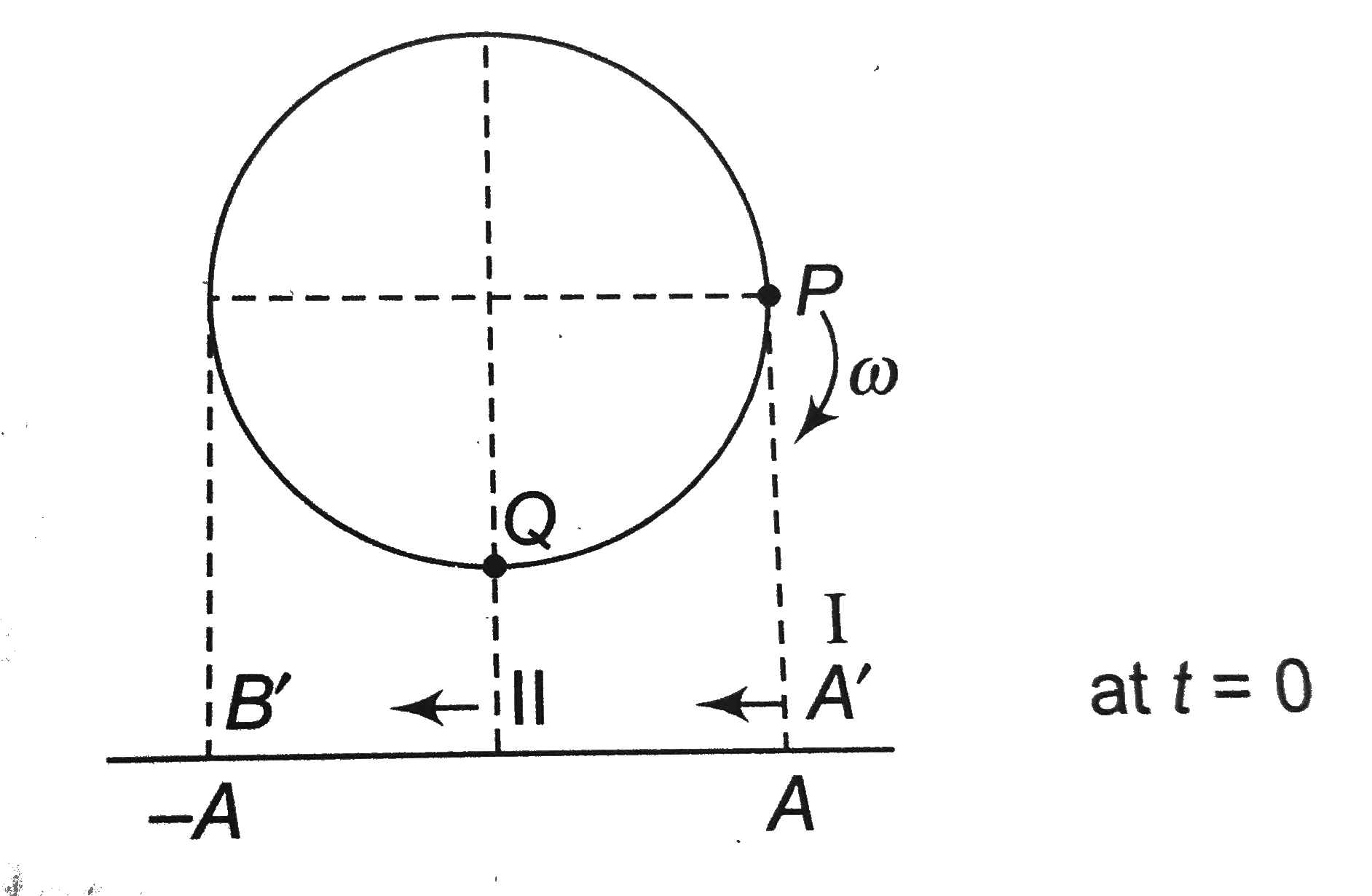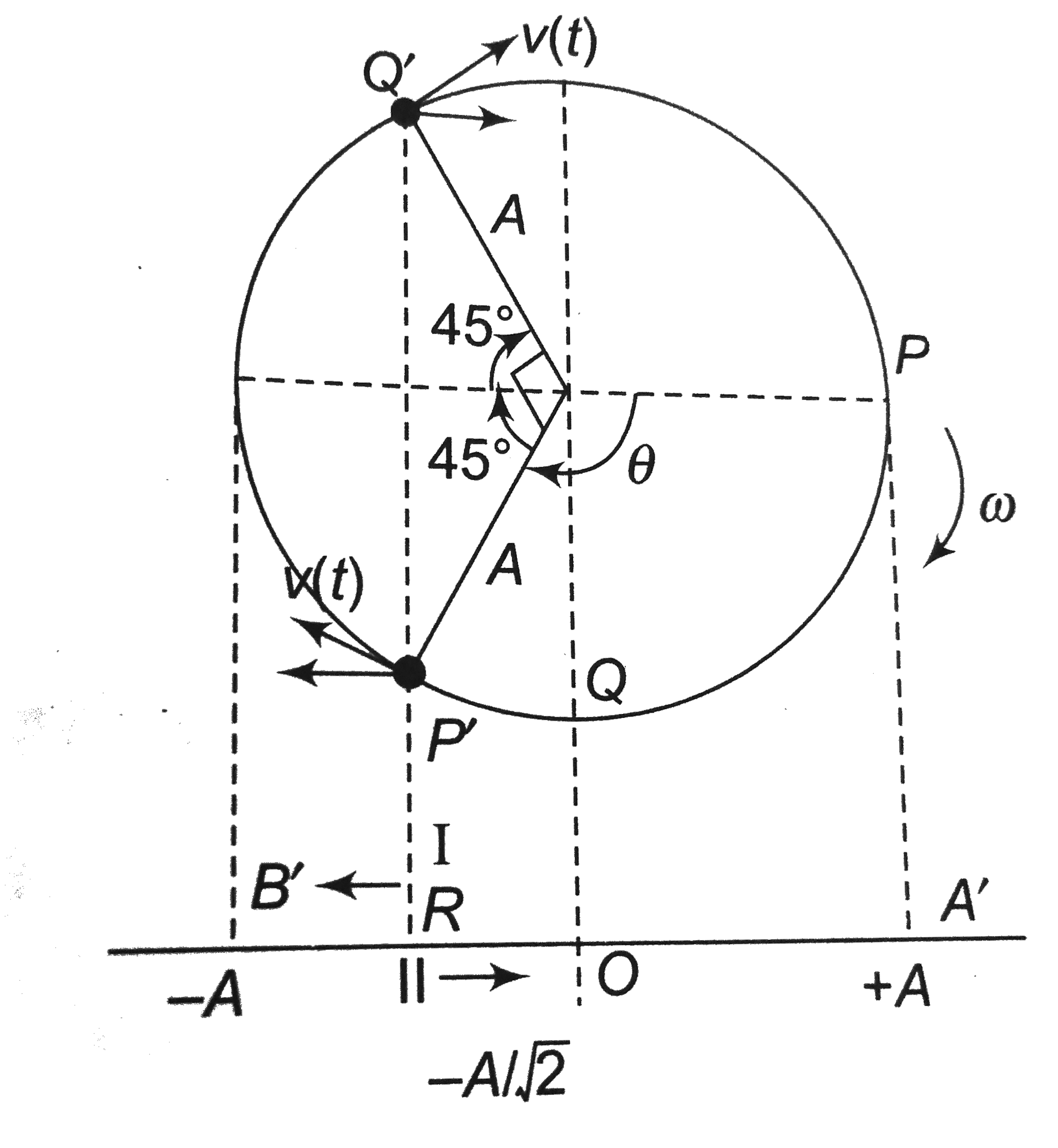Two particle undergoes SHM along parallel line with the same time period (T) and equal amplitude At a particular instant , one particle is at its extereme position while the other is at its mean position .They move in the same direction .They will cross each other after a further time

7/8
37/8
2/6
4/13
The correct Answer is:B
The problem is may to move with the help of phase diagram.Find we draw initial position of both the particle on the phase as shown in figure

From above figure difference between both the particle is π/2 They will cross other when their propertion from the circle in the horizontal diamater meat at the point
Let after time t both with each at P'Q' point haxing phese diffarence π2 as shown in figure

Both will ment at −A√2
When they angle displacement at P is
θ=π2+π4=3π4
So they will ment line t=3π4×ω
t=3π4×2π×T=3T8sec
Topper's Solved these Questions
- OSCILLATION AND SIMPLE HARMONIC MOTIONBOOK - A2ZCHAPTER - OSCILLATION AND SIMPLE HARMONIC MOTIONEXERCISE - Velocity , Acceleration And Energy Of Simple Harmonic Motion
40 Videos
- OSCILLATION AND SIMPLE HARMONIC MOTIONBOOK - A2ZCHAPTER - OSCILLATION AND SIMPLE HARMONIC MOTIONEXERCISE - Spring Particle System
24 Videos
- NEWTONS LAWS OF MOTIONBOOK - A2ZCHAPTER - NEWTONS LAWS OF MOTIONEXERCISE - Chapter Test
30 Videos
- PROPERTIES OF MATTERBOOK - A2ZCHAPTER - PROPERTIES OF MATTEREXERCISE - Chapter Test
29 Videos
Similar Questions
Two very small particles are executing SHM along very near parallel lines about the same mean position, same amplitude and the same frequency. At t=0 both the particle are moving with speed of 1m/sec but on the opposite side of the mean position and having same direction of velocity at a distance of 5cm from the mean position. At t=4sec they are at the same position moving with speed of 1m/sec but in opposite direction. Assuming that this is the minimum time form t=0 where they are meeting for the 1st time. If the maximum speed of either particle is xπ4√2cm/sec Find x
View SolutionTwo particles undergo SHM along the same line with the same time period (T) and equal amplitude (A). At a particular instant one is at x = -A and the other is at x = 0. If they start moving in the same direction then they will cross each other at

(i) t=4T3
(ii) t=3T8
(iii) x=A2
(iv) x=A√2
View Solution
Knowledge Check
Two particles undergo SHM along parallel lines with the same time period (T) and equal amplitudes. At particular instant, one particle is at its extreme position while the other is at its mean position. The move in the same direction. They will cross each other after a further time.
AT/2B3T/8CT/6D3T/4Two particles undergo SHM along the same line with the same time period (T) and equal amplitude (A). At a particular instant one particle is at x=−A and the other is at x = 0. They move in the same direction. They will cross each other at
 At = 4T/3Bt = 3T/8Cx = A/2Dx=A/√2
At = 4T/3Bt = 3T/8Cx = A/2Dx=A/√2Two particles undergo SHM along the same line with the same time period (T) and equal amplitude (A). At a particular instant one is at x=−A and the other is at x=0. If they start moving in the same direction then they will cross each other at

(i) t=4T3 (ii) t=3T8 (iii) x=A2 (iv) x=A√2Aonly i, ii, are correctBonly i,iv are correctConly ii,iii are correctDonly ii,iv are correct
Time period (T) and amplitude (A) are same for two particle which undergoes SHM along the same line. At one particular instant one particle is at phase3π2and the other is at zero, while moving in the same direction. Find the time at which they will cross each other
View SolutionAt a particular position the velocity of a particle in SHM with amplitude a is √3/2 that at its mean position. In this position, its displacement is :
View SolutionA particle performs SHM on a straight line with time period T and amplitudeA. The average speed of the particle between two successive instants, when potential energy and kinetic energy become same is
View SolutionThe amplitude of a particle in SHM is 5 cms and its time period is π. At a displacement of 3 cms from its mean position the velocity in cms/sec will be :
View SolutionA particle performs SHM with a period T and amplitude a. The mean velocity of particle over the time interval during which it travels a/2 from the extreme position is
View Solution
